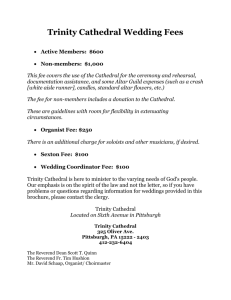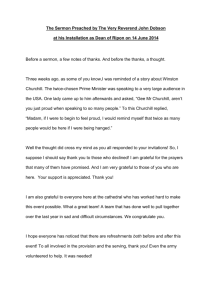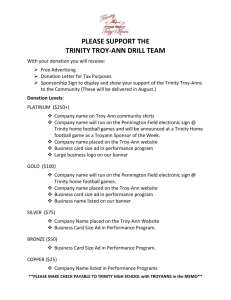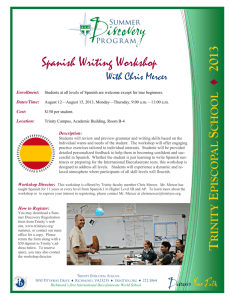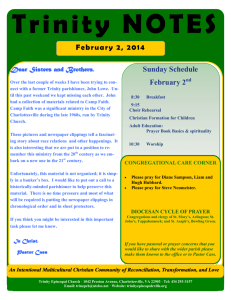The Carillon Newsletter
advertisement
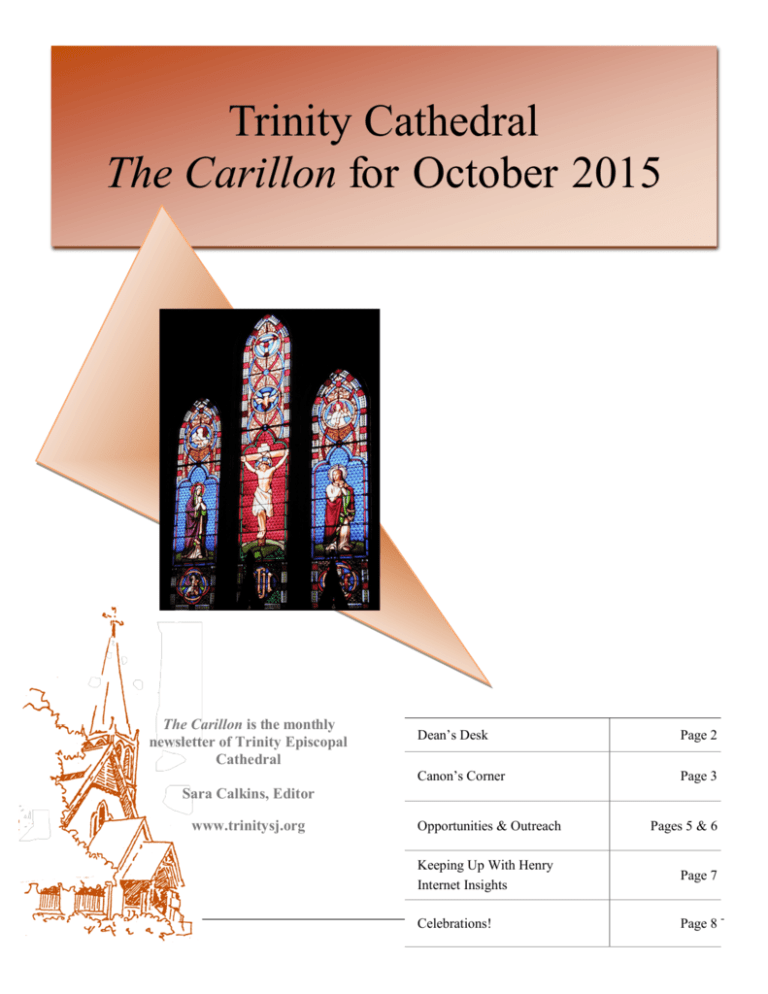
Trinity Cathedral The Carillon for October 2015 The Carillon is the monthly newsletter of Trinity Episcopal Cathedral Dean’s Desk Page 2 Canon’s Corner Page 3 Sara Calkins, Editor www.trinitysj.org Opportunities & Outreach Keeping Up With Henry Internet Insights The Carillon Celebrations! Pages 5 & 6 Page 7 Page 8 Page 1 The Carillon October 2015 Trinity Episcopal Cathedral “A place at God’s table for everyone” Diocese of El Camino Reál The Right Reverend Mary Gray-Reeves, Bishop Trinity Cathedral Staff The Very Rev. David Bird, Ph.D. Dean and Rector Mr. Michael Joyce Music Director Ms. Heike Merino Cathedral Administrator Mr. John Davis Sexton Volunteer Staff The Rev. Canon Randolf J. Rice, J.D. Canon Residentiary The Rev. Canon Lance Beizer, J.D. Canon Vicar The Rev. Lee Barford, Ph.D. Deacon Mr. Paul Archambeault Treasurer Graciela Velazquez Coordinator for Latino Ministries The Rev. Penelope Duckworth, M.F.A. Mr. Stuart Johnson Artists in Residence Professor Brent Walters Scholar in Residence Dean’s Desk On September 15, 2015 the Santa Clara County Board of Supervisors presented Trinity Cathedral of the Diocese of El Camino Real with a commendation recognizing the cathedral’s contribution to downtown San José. Founded in 1863, Trinity Parish has long been recognized for its ministry to the city of San José. Peter Williams Cassey, The Episcopal Church’s first clergyperson of color west of the Mississippi, was ordained a deacon at Trinity in 1866, and together with his family founded St Philip’s School. This was the first secondary school for children who because of their ethnic background were not permitted to attend San José public schools. A future rector of Trinity parish, the Rev. Bart Murdoch was a leading figure in the founding of Good Samaritan Hospital, InnVision, and Shires House, an apartment building with ninety-nine units for seniors on a limited income. Trinity was designated by Bishop Shannon Mallory as the cathedral of the Diocese of El Camino Reál, following a pattern in Anglicanism, which began in the nineteenth century, of designating historic downtown parish churches as the seat of the bishop in newly created dioceses. The then dean, the Very Rev. William Power Clancey, launched the first Spanish language service at Trinity, which in turn led to the founding of a parish mission, Nuestra Senora de Guadalupe. This mission was so successful that it was accepted into the diocese as a separate parish in 2003. Records filed with the Diocese of El Camino Real show that overall Sunday attendance from 1988 and 1991 was substantial, with 791 in 1988 the lowest. Though the (Continued on page 4) Trinity Cathedral Established 1861 81 N 2nd Street, San Jose CA 95113-1205 24-hour phone 408 293-7953 Fax 408 293-4993 E-mail: trinicat@pacbell.net Web site: www.trinitysj.org The Carillon Submissions to The Carillon may be sent via e-mail to the office or to editor, Sara Calkins, at calkins3@ix.netcom.com. Please indicate “For the Carillon” in the subject line. Page 2 Canon’s Corner One of the most interesting of literary devices is irony. And we shall see much of it in the fact that the object of this month’s offering from Holy Women, Holy Men is William Tyndale. Born in 1495, and therefore a young scholar when Martin Luther posted his 95 theses to the church door, Tyndale was a man obsessed with ensuring that the Bible be available to all to read in their everyday language. One of the central precepts of the Reformation was that all believers are priests. At the core of that doctrine is the recognition that if we are to be our own priests we must have access to scripture. I have heard people of a certain age, whose background was in the Roman Catholic Church, say that not only were they not encouraged to read the Bible; they were actually discouraged from reading it. What a tragedy! For, however you approach studying scripture—to use the scholar’s term, whatever your hermeneutic—first you have to actually read it. Now, I don’t know how familiar you may be with the various ways of reading the Bible. This may be old hat to you, but I think it is worth reminding us all of the ways in common use, since, if nothing else, it helps us to understand one another better. In Tyndale’s time there were really only two traditional ways to read the Bible—as pure history or direction as to how we are to live our lives—or as allegory, where everything stands for something else, a way in which even today we all tend to read the Songs of Songs. Although, during the Renaissance, questions about how the Bible was assembled, and also, of course, about the scientific worldview within it, began to be raised, by and large it was a period known today as pre-critical—that is to say, before the methodology of Biblical criticism was introduced. In that period, most Biblical stories were accepted as accurate reports of what actually occurred. Since the German academicians of the 19th Century introduced the methodology of science into Biblical criticism, however, questions about authorship, and context—what the Christian communities that produced the scriptures were like—have opened up entirely new ways of understanding the books of the Bible. There are those folks today who resist the use of those forms of criticism and analysis, people who read the Bible as if God actually The Carillon dictated it, the human hand needed only to transcribe that dictation. Every word to them is true and need only be understood in commonsense ways. Of course, some of those who accept the words of scripture in a literal manner are more sophisticated, recognizing that the Bible was originally written in languages other than English and also copied many times by scribes, and that therefore there must surely be mistakes passed down in either translation or transcription. These interpreters deal with those possibilities by insisting that whatever the final result of translation and transcription may be, it is surely what God intends, and that therefore the final version is not less accurate, but more perfectly inerrant than the previous manuscripts. There are those who even today believe that God himself wrote the King James Version. What is truly sad about the rejection of scholarship is that it has actually resulted in deaths. The end of Mark’s Gospel has for a long time generated controversy because it ends differently than do the others. There are, however, a couple of additions that have made their way into some of the manuscripts, resulting in its ending being more like those in the other Gospels. Unfortunately, not only were these additions not in the earliest manuscripts we have; they are written in a style and vocabulary quite different from the language of the rest of Mark’s Gospel. Therefore scholars are fairly uniform in their belief that they were added by scribes somewhat later. Nevertheless, they appear in the King James Version, which was produced well before the scholarship that resulted in that belief. One of the things that was added was the assertion that one can, if one truly believes, handle poisonous snakes, a practice that is found in some rural Southern churches, and that has in fact resulted in deaths. Others have reinterpreted or reconfigured Biblical details so as to make them work out in a literal way. There was a book a few years ago, for example, that explained the incredibly long reported ages of the patriarchs, like Methuselah for example, by supposing that the Earth spun more rapidly on its axis in the early days of its existence, thereby giving more years of life to people who lived then. The Episcopal Church has always insisted that however one approaches interpretation, both tradition and reason have to play a part and are thus important bulwarks (Continued on page 4) Page 3 Dean’s Desk, continued (Continued from page 2) parish subsequently fell on hard times and was closed on Guadalupe Day, 2011, there was no interruption of Spanish language services on Trinity’s premises. The Guadalupe congregación of Trinity parish is an integral part of the cathedral’s ongoing ministry. The commendation from the Santa Clara Board of Supervisors, presented by Supervisor Cindy Chavez, herself a resident of downtown, recognized several facets of Trinity’s ministry. Trinity houses four weekly 12 step programs plus additional counselling and scout programs. Volunteers cook and take meals twice monthly to two shelters. Trinity houses the office for “Hope with Sudan” and has a significant number of “Lost Boys” and their families among the parishioners. On September 26 at the suggestion of local Council Member Peralez’ staff, we plan to introduce a program begun in South Africa called “The Street Store,” a deliberately interactive program where people who have good quality clothing will bring it to Trinity and people in need of clothing come and select what they need. For two years we have been a distribution center for Second Harvest Food Bank. We serve roughly 150 registered persons in need on a given week from approximately 150 caseloads of food weighing a total of over 3,000 lbs. Finally, Episcopal Senior Communities’ Senior Resources, in partnership with Trinity Cathedral, has launched a program to help frail and elderly seniors with basic self-care and hygiene incontinence product assistance. The program has been running only four months and has already distributed over $4,000 worth of self-care products to 58 seniors. This program collaborates with 6 case management agencies county wide and fills a much needed gap by allowing those impacted to age at home with dignity. - David Canon’s Corner, continued (Continued from page 3) against interpretations that are too simplistic or idiosyncratic. Hence there is some irony in Tyndale’s name being placed on our calendar, for it is associated with one of the most conservative of Christian publishing houses, with some of the most simplistic and idiosyncratic books on its list—namely the Left Behind series, presenting Christianity from the perspective of those who believe in the rapture—a notion not even in the wildest of Christian minds until the 19th Century. Nevertheless, Tyndale himself holds a very special place in the history of postReformation Christianity. And thus another irony. First there was his singleminded determination to place the scriptures into the hands of everyone, not just Church-sanctioned theologians, culminating in the production of what has clearly been the most important religious book of our language—the much-loved, if sometimes inaccurate, King James Bible. Second, his efforts fostered the disThe Carillon semination of scripture—and thus of literacy—so that we may now have a personal encounter with the word of God, and thus with Jesus Christ himself. Tyndale himself was a very determined man, though it is said that he was personally also quite a genial one, who deserved far better than his fate, which was to be strangled at the stake and then burned— which leads us to the greatest irony of all: that his name should even be on our calendar. He was, it seems, hunted and killed through the efforts of Henry VIII, the king ultimately responsible for the formation of the church in which we ourselves worship. We give thanks for the life and work of this worthy man. May we be as diligent as he in what we see as God’s purpose for our own lives. —Lance Page 4 Opportunities & Outreach Support Trinity Cathedral Help Trinity raise money by shopping at amazonsmile.com. It is the same as the Amazon you know, except now 0.5% of your purchase goes towards Trinity Cathedral. Just use the link provided and start supporting Trinity. http://smile.amazon.com/ch/94-1156841. Thank you! Commendation Submitted by Jean Libby: The commendation by Supervisor Chavez on Sept. 15 was very helpful, I believe, in keeping current projects aloft. The history project that Rev. David talked about in his sermon for the Guadalupe congregation, is welcome in community archives as well as our own. Here are her remarks on Facebook, along with the link to the group picture she posted. I am pleased to present a commendation to Trinity Episcopal Church and Canterbury Bridge, SJSU Campus Ministries. Founded in 1861, the Trinity Episcopal Parish is the oldest church building in The Carillon San Jose in continuous use. In 1866, the church established St. Philip’s School in San Jose (recognized as the first Black secondary school in the western US), which served students of color who were denied access to California public schools. In 1989, Trinity Episcopal Church became the Cathedral of the Diocese of El Camino Real, with 45 congregations. Iglesia Nuestra Señora de Guadalupe Episcopal congregation was formed in 1995 to serve the Hispanic community. On April 18, 2015, Canterbury Bridge Episcopal Ministries at San Jose State University sponsored a campus symposium, “Standing Witness”, to commemorate the 150th anniversary of the 13th amendment, which abolished slavery in the United States. I was honored to attend the symposium, which very meaningfully explored issues of legal racism in California and traced the advances and struggles in civil rights and liberties of California pioneers of color. For these reasons and more, I am thrilled to present this commendation to Trinity Episcopal Cathedral and Canterbury Bridge, San Jose State University Campus Episcopal Ministries. Page 5 Opportunities & Outreach, continued Blessing of the Animals We will have the blessing of the animals on Sunday, October 4 at 9:30am in the parking lot. If you're planning to bring your live animal friends, make sure you have carriers, leashes, cages, etc as appropriate. Lunch for People Who are Homeless For the first lunch of September, an experienced group of 7 volunteers gathered on Saturday morning to cook and serve one of our favorite dishes, pasta with chicken and spinach, to the clients at Cecil White Center and Julian St. Inn. Along with the main dish is served garlic bread and green salad, milk, ice cream sundaes, and an assortment of pies and fruit. A big thank you also goes to Rick Hawes, who donated the lettuce and veggies for the salad, several containers of juice, a big bag of oranges, apples, and bananas, and a couple of delicious cheese cakes. At Cecil White Center, Karen organized the servers, with Karen serving the pasta, Susan serving the salad, and Davison giving out generous portions of garlic bread. Ben and Jennifer worked the dessert counter, giving out cheese cake, slices of pie and cake, and the ice cream sundaes. All the while, Rick handed out slices of sweet, juicy watermelon and arranged the other fruit for the lunchers to take and eat. A big thank you goes to Lucky supermarket, at the corner of Saratoga and Pruneridge Avenues in Santa Clara, and especially managers, Andrew and Reuben, and bakers, Bertha, Ernie, Amina, and Sandy for their continuing support. They donated loaves of hot and fresh French bread for our garlic bread and many mouth-watering cakes and pastries. Finally, another thank you goes to Ben for arranging, picking up, and delivering the baked goods. First of all, thanks go to Erin McCauley and her daughter, Holly, for buying all the groceries. (Thanks in advance to Lindy Hayes who will do the shopping for the second lunch in September that will be provided to the San Jose Family Shelter.) Thank you to Darryl Parker, who was the head chef this morning, slaving over the hot stove sautéing the chicken and veggies and concocting the delicious butter and garlic mixture for the garlic bread. Thanks also go to friends of the parish, Susan Parks and Ben White, who arrived early to clean and sanitize the counter top. Thanks go to parishioner Karen Gillette and to returning volunteers, friend of the parish, Jennifer Shortt, and parishioner Davison Hogan. Everyone pitched in to help cut up chicken, slice up lots of spinach, wash the many packages and bunches of veggies, grate carrots, make our super garlicky garlic bread, and wash the dishes and utensils. With such teamwork, we were able to quickly finish the prepping and cooking and transported the food to Cecil White Center in plenty of time for the 12:30 meal service time. The Carillon The next lunches will be held on October 10 and 17, 2015. At least 10 volunteers are needed for this local mission activity so if your schedule allows please consider coming and helping. We meet to prepare lunch at 10:15 am in the kitchen of the Parish Hall. No experience is required, just a desire to help those less fortunate than ourselves. There is a sign-up sheet on the bulletin board in the Parish Hall. If you have any questions, please ask any of the volunteers or Fr. Bird. - Alan Fong Page 6 Keeping Up With Henry! San Jose premiere of cantata ALL GOD’S CHILDREN The Winchester Orchestra will present the choral cantata ALL GOD’S CHILDREN, a work with both Latin and English texts, conducted by the composer, with the choirs of West Valley College conducted by Lou De La Rosa. Dates and Times: Saturday December 5, 2015, 7:30 PM, Trinity Episcopal Cathedral, San Jose, CA Sunday December 6, 2015, 3 PM, West Valley College Theater, Saratoga, CA Information: http://www.winchesterorchestra.com Performance of two Mollicone works with San Jose Chamber Orchestra “Postcards,” a program by the San Jose Chamber Orchestra, conducted by Barbara Day Turner, will include two works by Henry Mollicone: “Andrea’s theme” from the film THE PREMONITION, with piano solo by HM, and “IN PARADISO”, a short piece commissioned by the Winchester Orchestra for violin solo with strings. Soloist will be concertmaster Cynthia Baehr. Dates and Times: Saturday November 7, 2015, 8PM Sunday November 8, 2015, 2:30 PM Venue: Petit Trianon Theater, San Jose, CA Information: 408-295-4416 sjco@sbcglobal.net BEATITUDE MASS at St. Joseph’s Cathedral BEATITUDE MASS (mass for the homeless) will be performed as part of the “Season of Hope” concert series at St. Joseph’s Cathedral in San Jose, CA. The Choir of Stone Church, directed by Nancy Wait Kromm (augmented by members of the San Jose Symphonic Choir), with soloists Nancy Wait Kromm, soprano, and Leroy Kromm, baritone, and an instrumental ensemble. The composer will conduct. Date and time: December 17, 2015, 7:30PM Venue: St. Joseph’s Cathedral, 80 So. Market St, San Jose, CA Information: Free will donations will be accepted, and the proceeds will go to St. Joseph’s Social Ministry for their work with those in poverty. Internet Insights The fate of animals is of greater importance to me than the fear of appearing ridiculous; it is indissolubly connected with the fate of men. Emile Zola, writer (2 Apr 1840-1902) The Carillon Pets’ reactions to the aspergillum used for sprinkling holy water Page 7 Celebrations! Sara Calkins Leslie Bailey Ryan Dionne Sarah Nunes Patricia Anderson Jim Nelson Jack Beasley Dagm Teklu Aklilu Micah Dionne Lee Barford Dorothy Berry Mike Joyce Thomas Estruth 10/2 10/5 10/5 10/6 10/7 10/8 10/11 10/13 10/13 10/14 10/17 10/17 10/18 Dolores Laconico Peter Gillette Margo Estruth Philip Hanasaki Darryl Parker Marge Lobbes Janice Paull Doreen Volcere Mary Jo Melia Daniel Nelson Steve Franke 10/20 10/24 10/24 10/24 10/24 10/24 10/25 10/27 10/28 10/28 10/30 “O God, our times are in your hand: Look with favor, we pray, on your servants as they begin another year. Grant that they may grow in wisdom and grace, and strengthen their trust in your goodness all the days of their lives; through Jesus Christ our Lord. Amen.” Happy Anniversary! Michelle and Alan Fong The Carillon 10/24 Page 8
